Marlow Moss’s works are held worldwide in collections both private and public, including the Museum of Modern Art, New York and the Israel Museum in Jerusalem. She is especially well-represented in collections in the Netherlands, including the Stedelijk in Amsterdam, Gemeentemuseum in The Hague and Kröller-Müller in Otterlo. However, she remains little-known in the UK, despite being British, born in London, and working prolifically in Cornwall from 1941 until her death in 1958. Her last home and studio (fig.1) were in the village of Lamorna only a few miles from the modernists of St Ives such as Ben Nicholson and Barbara Hepworth, yet there was hardly any contact between them. Her comrades instead were continental European artists: Piet Mondrian, Georges Vantongerloo, Jean Gorin and Max Bill, friends she made in Paris in the years before the Second World War.
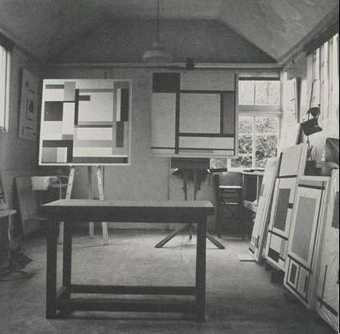
Fig.1
Marlow Moss’s studio in Lamorna, Cornwall, c.1958, private collection
Digital image Florette Dijkstra © reserved
The display at Tate Britain from September 2014, which includes paintings, reliefs, sculptures and a drawing, has toured from Tate St Ives (fig.2) over the last couple of years, appearing (with some variations) at the Jerwood Gallery in Hastings and Leeds Art Gallery.
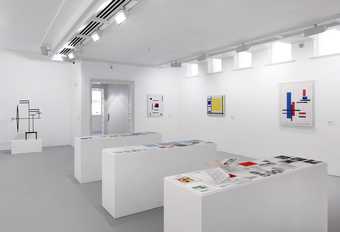
Fig. 2
Installation shot, Marlow Moss display, Tate St Ives, Summer 2013
Photo © Lucy Howarth
It is hoped that this, the first public gallery presentation of Moss to take place in the UK, will have served as an introduction to her work for the wider British public, and that the mounting of the display at Tate Britain will lead to her gaining a permanent place in accounts of 20th century British art. As Moss said: ‘Art is as – Life – forever in the state of Becoming’.1
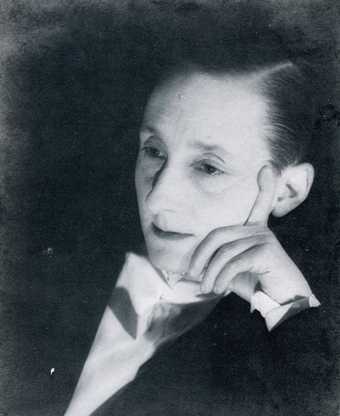
Fig. 3
Marlow Moss, 1938, photograph Stephen Storm, private collection
Digital image Florette Dijkstra © reserved
The queer portrait photographs of Moss taken by Stephen Storm, son of Moss’s partner the novelist AH (Netty) Nijhoff, have elicited great interest. Moss believed firmly in the existentialist idea of perpetual becoming, the awareness of the ability and responsibility to create one’s own existence through action. She changed her forename (from Marjorie) and adopted a masculine appearance in around 1919 (fig.3). This was precipitated by a ‘shock of an emotional nature’ (perhaps the discovery of her sexual orientation) and the abandonment of her studies at the Slade.2
In 1927 Moss moved from London to Paris and enrolled at the Académie Moderne, where she studied with Fernand Léger, a seminal influence. In 1931 her ‘double line’ paintings brought her to the attention of Mondrian who saw that she was augmenting his language of neoplasticism (Mondrian’s term for his signature geometric style). As a result Moss was invited to join the Paris association Abstraction-Création as a founder member along with Mondrian, Vantongerloo, Theo van Doesburg, August Herbin and Jean Arp, among others. This exhibiting and publishing organisation represented the unification of many factions of international non-figurative art, growing as it did from previous movements: De Stijl, Cercle et Carré and Art Concret. Moss found herself at the centre of a vibrant scene, and exhibited with her fellow artists in Paris shows, and in the exhibitions Konstruktivisten, Basel 1937, and Abstracte Kunst, Amsterdam 1938. At the same time she was active in several other Parisian groups: the Surindépendants, Groupe Anglo-Americain, Association 1940 and the Salon des Réalités Nouvelles.
Like many 20th century artists, Moss was deeply affected by the coming of modernity: science and technology. The arrival of sub-microscopic and atomic science led some artists to look inward to the structure of their art; if life itself was subject to knowable patterns, then so must art be. Advances in technology, and access to it, opened up a new range of materials and mediums – both practically and intellectually, clarifying the separation between art and matter. The age of mechanical reproduction allowed a shift in emphasis, from single hand-crafted objects, to art as series, industrial-scale art or art without the touch of the human hand.
Nijhoff described Moss as an atheist.3 Her universe was without a deity, aligning her with Vantongerloo and Max Bill. It was a universe of marvel and awe nevertheless, and this is expressed in Moss’s writing on art 4 the published tracts in Abstraction Création: Art Non-Figuratif from the early-1930s, a catalogue statement from the 1940s, and the unpublished manuscript entitled ‘Abstract Art’ written in the 1950s. The latter is a hand-written draft, with revisions and editing. It begins by overtly connecting art to the human mind:
Works of Art are the creations and expressions of conscious minds or primitive emotions. Outside man, Art does not exist.5
This can be understood as both a humanist and atheist statement. Revealingly she has written, and subsequently (in a different ink) crossed out; ‘…the greater the artist the less we are aware of the type of man he is’. Following this, in brackets, is ‘Egyptian and Greek Art’. Although Moss had not found the appropriate words to convey her thoughts, her meaning can be understood; she wished to connect constructive art, and particularly her own practice, to an eternal notion of art, while dispensing with surplus elements such as representation and allusions to literary or moral values. Moss saw constructivism as an artistic lingua franca that overrides personality and biography. Her statement in the first issue of Abstraction Création: Art Non-Figuratif, of 1932, also explores this theme:
…natural forms …are composed of two elements, that is, one changeable element, in that they are visible forms, and one unchangeable element, in that they belong to this universal truth, which is not visible. Their true value is … not found in their visible form but in the relation that exists between this form and the universe… [The non-figurative artist] aims to construct pure plastic art that will be able to express in totality the artist’s consciousness of the universe.
Her evocation of the universe places Moss within the tradition of constructivism defined by Naum Gabo in his ‘Realistic Manifesto’ of 1920.6 Echoes of Mondrian’s ideas can also be traced, and it is likely that she was reading his published writing at the time. Her reference to ‘the artist’s consciousness of the universe’ is reminiscent of Mondrian’s dualism of the subjective and objective in ‘The New Plastic in Painting’, where he states that ‘the subjective is growing towards the universal’.7
The writings of Matila Ghyka, D’Arcy Wentworth Thompson, Theodore Cook, and Jay Hambidge were part of the theoretical landscape for constructivist artists, and would have been familiar to Moss. Through these texts, and her friendship with Vantongerloo, Moss developed a knowledge of mathematics and geometry sufficient for her purposes. She came to know Ghyka personally, and it is his conception of the geometry of both art and nature that is most apparent in the development of her ideas.
Moss’s innovation, the double line (parallel lines in close proximity), was a motif she returned to in various guises for many years, and incarnations of it can be seen in works included in the Tate display. Moss’s ‘invention’ of the double line, was later adopted for a time by Mondrian, Gorin and others. The lively exchange of constructivist ideas is documented in letters between the artists, and innovations were adopted, adapted and discarded.8 Nijhoff, quoting Moss from memory, states that the purpose of the double line was to render ‘the composition dynamic instead of static’.9 This implies that Moss found Mondrian’s work deficient in this respect, and dispels the notion that she was merely a follower or imitator, as has sometimes been suggested. Another development in neoplasticism that originated with Moss was the vertically elongated canvas. Her ultimate aim, as Nijhoff recorded, was to attain ‘space, movement and light’ in her art.10

Fig. 4
Marlow Moss, preliminary drawing for White, Yellow, Blue and Red 1956, pencil, gouache and collage on paper, private collection
Digital image Florette Dijkstra © reserved
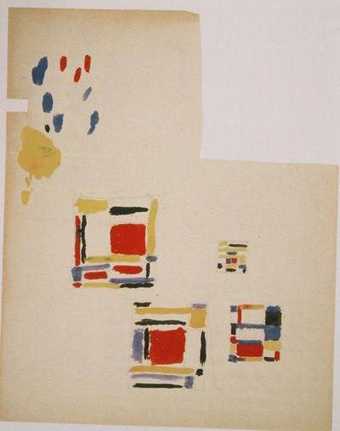
Fig. 5
Marlow Moss preliminary thumbnail sketches, undated, gouache on paper, private collection
Digital image Florette Dijkstra © reserved
Moss left no account of her working method, nor did she discuss materials in her writing on art. In her finished work, there is no trace of the process of construction. This makes Untitled (White, Black, Blue and Yellow) 1954, on permanent loan to Tate, of special interest, as it is unfinished, with pencil lines mapping out the composition still visible. Surviving works on paper include thumbnail sketches in watercolour and gouache, with dabs of colour, tentative and playful (fig.4 and fig.5). From these initial sketches Moss progressed to a working drawing, finding the mathematical relationships between the areas. In contrast to the freedom of the initial sketch, the working drawings are precise, executed with a sharp pencil, ruler and compass. These drawings are edged with notes and calculations in pencil. Often Moss collaged painted paper, further refining the divisions. Once the complete composition was arrived at, the drawing was transferred to the prepared canvas. The final painting was then executed. Building up layers of thin translucent paint Moss gradually arrived at the desired intensity of colour, and the realisation of her scheme. This approach is distinct from Mondrian’s, where traces of adjustments to the final composition remain visible on the canvas. Another significant difference between the working processes of Moss and Mondrian, indicated by the unfinished Moss canvas at Tate, is that Moss applied the white paint last, while Mondrian applied white first and worked on top of it.
Tate’s Composition in Yellow, Black and White 1949 (fig.6) is part of a series of shallow linear reliefs dating from that decade. These feature thin white three-dimensional lines of rectilinear wood articulating grid structures, and coloured sections; the language of the relief is integrated into that of painting. The perceptual difference between the support of canvas and that of wood becomes less prominent. The most visible element is the oil paint, the buttery texture of the rich colour built up out of layers of pigment and linseed oil. The rich glow of the lemony yellow, walled in by the relief, casts a violet sheen onto the white: Moss may have tinted the white paint to enhance this effect. The composition is controlled by two small black rectangles, punctuating the arrangement of forms and balancing the vertical format, a device repeated in a larger work of the same year.
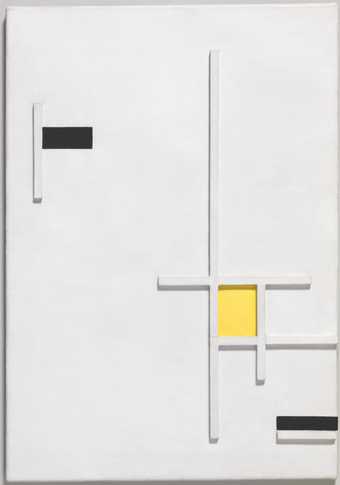
Marlow Moss
Composition in Yellow, Black and White (1949)
Tate
Moss displayed and photographed Tate’s sculptural piece Balanced Forms in Gunmetal on Cornish Granite 1956–7 (fig.7) with the objects arranged in different formations, and with different pieces of stone as a base.
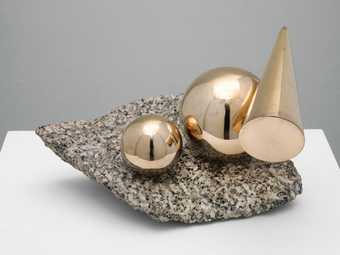
Marlow Moss
Balanced Forms in Gunmetal on Cornish Granite (1956–7)
Tate
This caused some confusion for the Assistant Keeper in 1969. Upon receipt of the work he wrote to Moss’s former dealer Erica Brausen:
Is the sculpture the same work as that reproduced on the cover of the catalogue of the Hanover Gallery Marlow Moss exhibition of 1958?…In the 1958 catalogue photograph the metal elements are … quite differently arranged in relation to one another, and appear to be mounted on a smaller piece of granite… Is our sculpture therefore a different piece, … or did the artist have in mind that the positions of the given elements should be varied at will?11
This invites questions regarding the nature of an object as a work of art: is it the same sculpture if its constituent parts are arranged differently? If it is, then Moss had found one way to imbue a work with movement, both potential and literal.
Moss provided a succinct and definitive statement on her work in a small catalogue in 1949:
I would like to ask the public to look at the work, as free as possible from preconceived ideas on art. These drawings are constructed on a very simple principle – a geometrical figure – sometimes broken, sometimes cut, sometimes divided, sometimes sub-divided – until the relation of the lines to each other produce an aesthetic emotion.
If one considers the lines in these drawings as sounds (note or chord progressions) and the geometrical figure as the musical key, one can, to a certain extent, compare these drawings to music.
Music is the ‘art of combining sounds with a view to beauty of form’; this work aims at ‘beauty of form’ by coordinating form and line on the plane.
Quoting from Plato….. what I understand by beauty of form is, something characterized by straight lines and circles, surfaces and solid bodies composed with the straight line and the circle by means of the compass, the set-square and the plumb. For these forms are not like the others (natural forms), beautiful under certain conditions, but are always beautiful in themselves….12
Moss cannot be confined to one particular field of academic study, as she pertains to several: British art history, European art history, feminist art history, queer art history. Moss relates to them all, and this is one reason for her obscurity. She was a British artist in Paris, a European in Cornwall, and woman artist among men. She disrupts and subverts the histories that could include her, and in the search for a coherent artistic narrative, has often been left out. However, despite being absent from almost all dictionaries and surveys of British art history, Moss’s name can be found. She appears in footnotes in books on Mondrian, specifically when the double line is discussed, and in chronologies and back pages (for example in the announcement of the 1937 Basel exhibition at the end of Circle).13 Moss also surfaces in less obvious places; in 1994 a Dutch dance group choreographed and performed a dance about her work at an exhibition in Arnhem, and in September 2014 a libretto entitled De schrijver, zijn vrouw, haar minnares (The Writer, His Wife and Her Lover) about Moss and the Nijhoffs, was performed as part of the Zeeland Nazomerfestival in Middelburg. Curiously Moss has become a fictional character on several occasions; she appears in two novels written by Nijhoff, and more recently the Dutch artist Florette Dijkstra moved from biography to invention in her writing on Moss.14 The critic Tom Lubbock once suggested, facetiously, that Moss was just a work of fiction who never really existed at all.15
A factor in Moss’s lack of recognition is that much of her output from before 1939 was destroyed during the war. Consequequently she is now represented in exhibitions mainly by late works. This is problematic as she appears to be an artist of the 1950s rather than the 1930s, and as a fully-fledged constructivist without a journey-to-abstraction back-story to humanise or legitimise her. Without any evidence that Moss could draw proficiently in an academic style or examples of her early explorations in impressionism, cubism, etc to demonstrate her artistic evolution, it has proved difficult to accept Moss as an artist of comparable standing to contemporaries like Mondrian. The same effect is apparent in Herbert Read’s 1959 Concise History of Modern Painting, where Moss is represented only by a late work; she is decontextualised, separated from her peers, and dismissed as anachronistic. Histories of art, and particularly of the avant-garde, tend to be discussed as a series of revolutionary developments. As a result, Moss has been marginalised.
Another, related, difficulty in the appraisal of Moss, is that of nationality. She was British, and the works on display were made in the UK, but crucially do not conform with concurrent British practice. If the war had not forced her from the continent, she would have remained as an ex-pat artist among other ex-pat artists. If she had gone from there to New York, as Mondrian did, her legacy might have been different. In 1940 Moss chose to settle in England, in Cornwall, her childhood sanctuary. This return home was initially as an exile. However after the war Moss continued to live in Lamorna, at least for part of the year (she also spent time in the Netherlands), until her death in 1958. A similar move on the part of the international dadaist Kurt Schwitters, who from 1945 resided in the English Lake District, has had a much less detrimental impact on his subsequent reception, probably because his reputation was already established, but also perhaps because he was not actually British.
To be cut off, almost entirely, from one’s previous work, at the age of 50, is unusual, although more common in wartime. This loss for Moss coincided with that of her home, adoptive country, partner (Nijhoff did not join her until after the war), friends and comrades. Though this feeling is documented in letters between her and Vantongerloo, she must also have experienced a sense of freedom, independence, and challenge; this was another opportunity for reinvention.16 She worked with vigour and energy during this period, and what she produced represents an accomplished culmination to her oeuvre. She exhibited locally in Cornwall, and in her last five years held two retrospective exhibitions at the Hanover Gallery in London (1953 and 1958), and took part in several group shows, including two in London: Groupe Espace at the Royal Festival Hall, and Measurement and Proportion at the Artists’ International Association Gallery, both in 1955. While she continued to exhibit on the continent and in the States (actively courting the attention of Alfred Barr in a cablegram of 1942, held in the MoMA Archives, New York), Moss also sought to represent herself and her art in her native land, and forge connections with British artists. She was to be disappointed by the decidedly cold, even hostile, reception she received. Moss’s brand of austere geometric non-figurative art did not appeal to British popular taste, and if in continental Europe she was surrounded by an established cultural scene and like-minded artists, in England this was not the case.
Letters (held in the Tate Archive) from Moss to her friend Paule Vézelay record the failed attempt to establish a British branch of the European Groupe Espace. The older generation (including Nicholson and Henry Moore) were not interested in restricting themselves to abstract art, and the younger generation would not accept the authority of Vézelay, or indeed continental European artists, preferring to make connections in America. By the time Moss exhibited her work at the Hanover Gallery in the 1950s, it looked to some like a throwback to a pre-war dalliance with continental ideas that had long since lost momentum. Young artists that Moss might have met through Espace – Victor Pasmore, Adrian Heath and Kenneth Martin, with Mary Martin, Anthony Hill and Gillian Wise – were developing a constructive approach, and went on to be known as the constructionists (their work was shown at Leeds Art Gallery alongside the 2014 Moss display, fig.8).
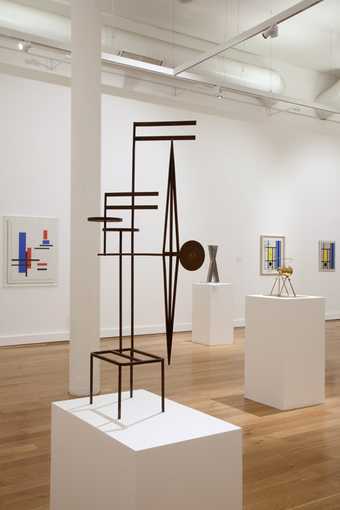
Fig. 8
Installation shot, Marlow Moss display, Leeds Art Gallery, Summer 2014
Photo © Lucy Howarth
They organised several exhibitions, including This Is Tomorrow (which came directly out of their rebellion from Espace), and then Statements at the ICA, and Dimensions at the O’Hana Gallery, in 1957. They promoted their ideas in the self-published Broadsheet, were championed in print by Herbert Read and Lawrence Alloway, and supported by institutions such as the Arts Council and the ICA. Juxtapositions of Moss’s work with that of the constructionists reveal compelling congruity. Pasmore’s relief works of the early 1950s, eg. Abstract in White, Black, Indian and Lilac 1957 (fig.9) share a sensibility with Moss’s reliefs of the 1930s – the dominance of white, vertical articulation and delicate linearity. Mary Martin’s coloured perspex reliefs of the late 1960s have the same visual language as much of Moss’s oeuvre, with their heightened saturation and square format. Heath’s Light Screen 1954 (held in the Tate Archive Collection: TGA 8318/26), recalls such works by Moss as White, Black and Red 1950, with its dominance of white and floating vertical and horizontal articulations. Hill’s Relief Construction 1956 (collection of the artist), is reminiscent of Moss’s Composition in White, Black and Red (lent by the Stedelijk Museum, Amsterdam for the Tate St Ives display) of three years earlier; the central horizontal double line appearing as if as a direct quotation. Kenneth Martin’s Line in Space mobile sculptures of the early 1950s connect with works by Moss of the previous decade such as Spheres and Curved Lines 1945, and Moss too was working with mobile structures in the early 1950s. However, there is no record of any sustained contact between these artists and Moss, nor have they claimed her as a predecessor. It seems rather that the they came independently to similar conclusions. Nevertheless, it is possible to suggest Moss as crucial influence on the development of the British constructive aesthetic – a missing link between pre-war international constructivism and post-war British constructionism.
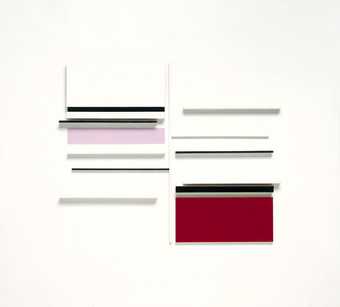
Victor Pasmore
Abstract in White, Black, Indian and Lilac (1957)
Tate
They did all exhibit together in the aforementioned 1955 show, Measurement and Proportion. It is not known how Moss came to be invited to contribute, but it is clear that the exhibitors were carefully selected to explore the particular theme, and at that point at least Moss was recognised as a significant and senior figure. She exhibited three works, and commanded the highest prices among the contributing artists. Matila Ghyka’s signature can be found in the visitors’ book (now held in the Tate Archives); it is possible Ghyka visited the exhibition at the invitation of Moss. The other artists were, of course, much younger than Moss (nearly 20 years in the case of Pasmore and the Martins, 30 for Heath, and 40 for Hill). At the time the constructionists were emerging, Moss was at the end of her life. Rather than being an anachronism, left over from pre-war Europe, Moss may have been ahead of her time in the UK. Through misfortune and mis-timing she has yet to find a place in British art history.
In 1973 Norman Reid, then Director of the Tate Gallery, visited the Moss exhibition at the Gimpel & Hanover Galerie in Zürich, and reserved two works for the Tate Collection. There followed some correspondence between them17 Eventually, the Tate Trustees decided against the purchase. Ronald Alley, Keeper of the Modern Collection, wrote that he was ‘personally … rather sad at the … decision’.18
Over 40 years later, Tate has had the opportunity to reconsider, and one of the works, White and Yellow 1935, now enters the collection. Crucially this is a pre-war work and its acquisition helps redress the balance in the representation of Moss. White and Yellow is one of the earliest examples of a series of works Moss made in the period prior to the start of the Second World War, with string and eventually rope glued onto the canvas. The relief technique was adopted in an effort to eliminate the use of black, which she felt hampered the expression of light, while retaining linear structure. Variations of the double line feature in the composition. Moss chose this work, and one other, to represent her in the fifth and final cahier Abstraction Création: Art Non-Figuratif, published in Paris in 1936.
Moss’s work is European and belongs to the international tradition of constructivism. But she is a British artist, one of a few radical modernists, who made some of her most significant art works in the UK. A British appraisal of her work, and celebration of her achievement, is overdue.
Lucy Howarth is the Co-Curator of the Tate Display Marlow Moss which toured 2013–2014 from Tate St Ives, to the Jerwood Gallery in Hastings and Leeds Art Gallery, and opened at Tate Britain in September 2014.
We are committed to respecting the intellectual property rights of others. While all reasonable efforts have been made to acknowledge copyright holders, we welcome any information that might help us update our records. Please email copyright@tate.org.uk if you have any such information.
